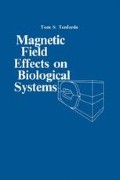Abstract
Magnetic fields could influence cellular development and function through an effect on the diffusion rate of ions across the plasma membrane.1,2 However, a comparison of the Larmor radius of an ion with its mean free path in solution indicates that a stationary magnetic field of megagauss strength would be required to measurably affect diffusion. An experimental approach to this question has been taken, in which magnetically-induced changes in ion diffusion rates have been studied by measuring the conductivity of CsCl solutions in the presence and absence of a magnetic field. For this purpose, an ac bridge circuit was employed in which the frequency was ~103 times lower than the Larmor frequency (~107 Hz at 1 kG). A null-point conductivity measurement was made to detect any imbalance of the bridge circuit resulting from application of a magnetic field, thus signifying an influence of the field on the ionic diffusion coefficient. No imbalance of the bridge circuit was observed following the application of fields of up to 1 kG strength, a result which is in conformity with theoretical predictions.
Access this chapter
Tax calculation will be finalised at checkout
Purchases are for personal use only
Preview
Unable to display preview. Download preview PDF.
References
Liboff, R. L., 1965. A biomagnetic hypothesis. Biophys. J. 5:845–853.
Liboff, R. L., 1969. Biomagnetic hypotheses. In Biological Effects of Magnetic Fields. Vol. 2, ed., M. F. Barnothy. New York: Plenum Press.
Keynes. R. D., 1958. The nerve impulse and the squid. Sci. Amer. 199(6):83–90.
Hodgkin. A. L. and Huxley. A. F., 1952. A quantitative description of membrane current and its application to conduction and excitation in nerve. J. Physiol. 117:500–544.
Katz, B., 1966. Nerve, muscle and synapse. New York: McGraw-Hill Book Company.
Liberman, E. A., Vaintsvaig. M. N.,and Tsofina, L. M., 1959. The effect of a constant magnetic field on the excitation threshold of isolated frog nerve. Biophysics 4:152–155.
Labes, M. M., 1966. A possible explanation for the effect of magnetic fields on biological systems. Nature 211:968.
Teucher, I., Baessler, H., and Labes, M. M., 1971. Diffusion through nematic liquid crystals. Nature (London) Phys. Sci. 229:25–26.
Hakemi, H., and Labes, M. M., 1974. New optical method for studying anisotropic diffusion in liquid crystals. J. Chem. Phvs. 61:4020–4025.
Hakemi, H., and Labes, M. M., 1975. Self-diffusion coefficients of a nematic liquid crystal via an optical method. J. Chem. Phvs. 63:3708–3712.
Cope, F. W., 1971. Evidence from activation energies for super-conductive tunneling in biological systems at physiological temperatures. Physiol. Chem. Phys. 3:403–410.
Wolf, A. A., and Halpern, E. H., 1976. On a class of organic super-conductors: A summary of findings. Proc. IEEE 64:357–359.
Wolf, A. A., 1976. Experimental evidence for high-temperature organic fractional superconduction in cholates. Physiol. Chem. Phys. 8(6):495–518.
Antonowicz, K., 1974. Possible superconductivity at room temperature. Nature (London) 247:358–360.
Cope, F. W., 1973. Biological sensitivity to weak magnetic fields due to biological superconductive Josephson junctions? Physiol. Chem. Phys. 5:173–176.
Antonowicz, K., 1975. The effect of microwaves on dc current in an Al-carbon-Al sandwich. Phys. Status Solidi a28:497–502.
Cope, F. W., 1976. Superconductivity — a possible mechanism for non-thermal biological effects of microwaves. J. Microwave Power 11:267–270.
Svvenberg, C. E. and Geacintov, N. E., 1973. Organic molecular photophysics, Ch. 10, ed., J. B. Birks. New York: John Wiley and Sons, Inc.
Groff, R. P., Merrifield, R. E., Suna, A., and Avakian, P., 1972. Magnetic hyperfine modulation of dye-sensitized delayed fluorescence in an organic crystal. Phys. Rev. Lett. 29:429–431.
Groff, R. P., Suna, A., Avakian, P., and Merrifield, R. E., 1974. Magnetic hyperfine modulation of dye-sensitized delayed fluorescence in organic crystals. Phys. Rev. B9:2655–2660.
Schulten, K. and Weiler, A.. 1978. Exploring fast electron transfer processes by magnetic fields. Biophys. J. 24(1)-.295–305.
Schulten, K., Staerk, H., Weiler, A., Werner, H. J., and Nickel, B., 1977. Magnetic field dependence of the germinate recombination of radical ion pairs in polar solvents. Z. Phys. Chem. NF101:371–390.
Blankenship, R. E., Schaafsma, T. J., and Parson, W. W., 1977. Magnetic field effects on radical pair intermediates in bacterial photosynthesis. Biochim. Biophys. Acta. 461:297–305.
Hoff. A. J., Rademaker, H., Grondell, R. V., and Duysens, L. N. M., 1977. On the magnetic field dependence of the yield of the triplet state in reaction centers of photosynthetic bacteria. Biochim. Biophys. Acta 460:547–554.
Schulten, K., Swenberg, C. E., and Weiler, A., in press. A biomagnetic sensory mechanism based on magnetic field modulated coherent electron spin motion. Z. Physik. Chem.
Author information
Authors and Affiliations
Editor information
Editors and Affiliations
Rights and permissions
Copyright information
© 1979 Plenum Press, New York
About this chapter
Cite this chapter
Liboff, R.L., Mahlum, D.D., Labes, M.M., Cope, F.W., Swenberg, C.E. (1979). Theoretical Aspects of Magnetic Field Interactions With Biological Systems. In: Tenforde, T.S. (eds) Magnetic Field Effect on Biological Systems. Springer, Boston, MA. https://doi.org/10.1007/978-1-4615-9143-6_7
Download citation
DOI: https://doi.org/10.1007/978-1-4615-9143-6_7
Publisher Name: Springer, Boston, MA
Print ISBN: 978-1-4615-9145-0
Online ISBN: 978-1-4615-9143-6
eBook Packages: Springer Book Archive

